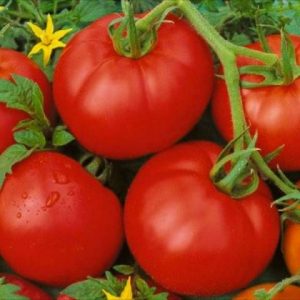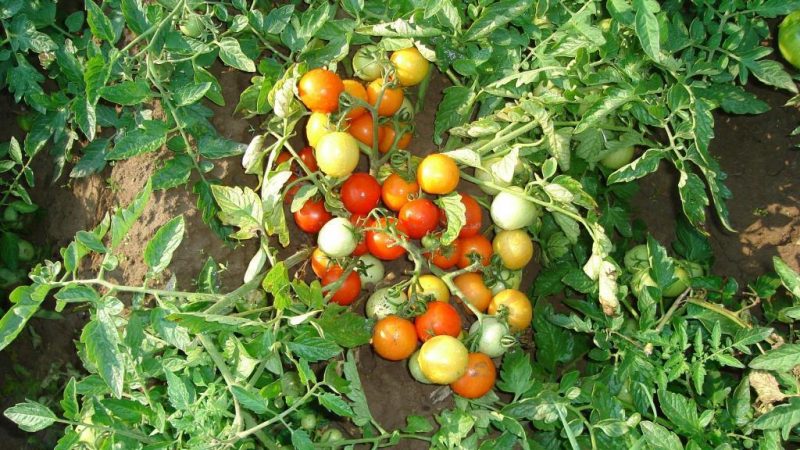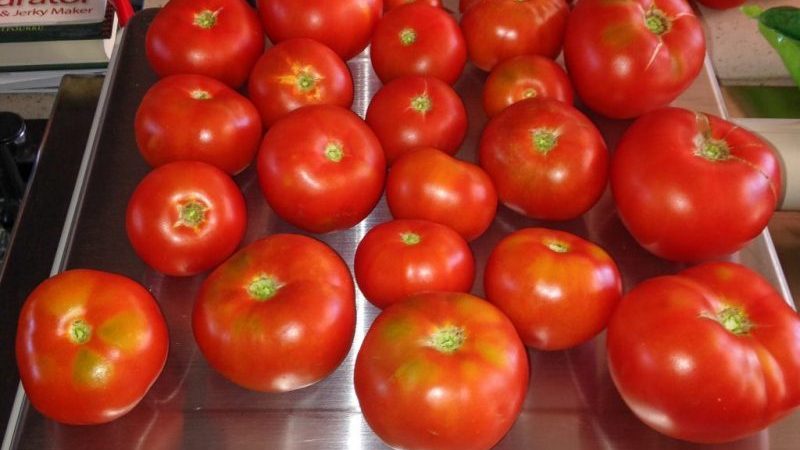Review of the Moskvichka tomato variety: pros and cons, as well as how to get a good harvest
Tomato is classified as a thermophilic crop. With all the variety of varieties, few of them are able to give a good harvest in regions with a temperate and cold climate, especially in the open field. And every gardener dreams of growing tomatoes with excellent taste.
The Moskvichka variety has long established itself as high-yielding and unpretentious. Like all tomatoes, it has its own characteristics, which we will talk about.
The content of the article
Characteristics and description of the Moskvichka variety
The history of Moskvichka began in 1976, when the crossing of the Smena 373 and Nevsky varieties resulted in a new early ripe and fruitful variety. The selection was carried out by the Institute of General Genetics of N.I. Vavilov. It is with the Moskvichka tomato that inexperienced gardeners are advised to start growing tomatoes.
Moskvichka tomatoes are resistant to cold climates and yield crops in the northern regions. Despite the harsh weather conditions, they can be planted outdoors.
Tomato Moskvichka - determinant variety, it stops growing on its own, forming 3-4 clusters on the main stem.
The bushes are strong, with dark green leaves, no more than 40 cm high. The foliage is small.
Moskvichka belongs to the standard varieties. They are distinguished by a small root system, which will not allow the bushes to form tall.
The variety is early maturing, the crop can be harvested as early as 90 days after planting in the ground. If the summer is cool, this period increases by one and a half to two weeks.
Advantages and disadvantages
Moskvichka tomatoes have practically no flaws, but the advantages cannot be hidden. Gardeners prefer this variety because they get:
- tomatoes with excellent taste;
- high productivity;
- beautiful, smooth, even fruits;
- a culture resistant to cold and disease, which does not require special conditions;
- a wide range of cooking applications.
The disadvantages could be attributed to the small size of the fruit. On the other hand, it enables whole-fruit canning.
Important! A distinctive feature of the Moskvichka variety, which must be reckoned with, is their exactingness to the nutrient substrate.
Productivity and characteristics of fruits
The Moskvichka tomato is a kind of high-yielding varieties.... Up to 2 kg of tomatoes are harvested from 1 sq. m with a normal planting, and if all agrotechnical requirements are met, the amount of the crop increases to 4 kg.
Fruits at the stage of full maturity are bright red, flat-rounded. They have a rich sweet taste, juicy and fleshy flesh, soft but firm skin. One tomato weighs on average 60-80 g.
The fruits collected before full ripeness are able to ripen at home. They tolerate transportation well and can be stored for a long time.
We grow tomatoes Moskvichka
The maximum return from cultivating a variety is obtained by following a few simple, but important rules. Mindfulness in the little things often helps to achieve record results.
Planting seeds
When growing tomatoes of the Moskvichka variety, it is not necessary to renew the seed.
For selection of seeds, ripe fruits are taken. They are cut and kneaded until smooth, covered with gauze and left until the mixture begins to ferment. The seeds are removed after the formation of bubbles and a white film on the surface. Then washed, dried and stored in a paper bag until sowing.The Moskvichka tomato is planted in late March or early April.
Before planting, the seeds are disinfected to exclude the appearance of pathogens. They are placed for 20 minutes in a 1% solution of potassium permanganate, and then for 18 hours in a solution of a growth stimulator ("Epin-extra" or "Zircon").
Important! Seed germination will be higher if sown immediately after disinfection.
The depth of the planting container should be at least 7 cm and equipped with drainage. For the seed mixture, peat soil, vermicompost and sand are usually used in equal amounts. Seeds are planted to a depth of 1.5 cm, 2 grains in each cup.
The seeded containers are moistened and covered with plastic wrap to create a greenhouse effect. Seedlings appear in about 5 days, at this moment they remove the film and put the seedlings in a bright place, preferably on the south side. Further, the cultivation continues with the parameters of humidity 30-60% and temperature + 22 ... + 24 degrees.
Seedling care
When the soil in cups with seedlings dries up, it is necessary to water... You can add melt water when watering, and use a stimulator (HB101).
After a month and a half, the seedlings are ready for transplanting into open ground, but they can be planted only after the ground warms up above 15 degrees.
Important! Moskvichka is a light-loving variety, therefore, on the site you need to choose a well-lit place, avoiding shade and partial shade.
Agricultural technology in the open field and greenhouse

Seedlings are planted in prepared soil. To do this, in the fall, when digging a future garden bed, humus or compost is introduced into the ground, and superphosphate is added there.
For each bush, dig a hole and moisten it with warm water. After planting the ground around the bushes mulch crushed straw.
Watering is carried out in such a way that the beds do not become waterlogged and dry. Bushes need feeding every two weeks. Organic and mineral fertilizers alternate.
Since the Moskvichka variety is undersized, there is no need to tie up the bushes. They also do not need pinning.
Protection against diseases and pests
The Moskvichka tomato is considered one of the most resistant to diseases of the nightshade, but due to its early maturity, it can be exposed to late blight... Diseases can be avoided by using Fitosporin. This is a biological product that does not cause toxic effects. You also need to loosen the soil and weed the weeds in a timely manner. For the prevention of diseases, it is recommended to remove the lower leaves from the bushes.
Diseases are not the only problem with tomatoes. They are very fond of various pests, which damages the crop. The Moskvichka tomato is most often attacked by the Colorado potato beetle, spider mite, thrips and aphid... Insecticides are used to control insects.
It is recommended to start processing at the first symptoms of plant damage. Spraying should be stopped during the flowering period, and 40–45 days before ripening, process one more time. From folk methods, garlic solution and ash are suitable.
Reviews of gardeners

The Muscovite is liked by both beginners and experienced gardeners. It is especially appreciated by residents of the northern regions.
Nikolay, Vologda: “I am pleased with the unpretentiousness of the Muscovite. I can't devote much time to the garden, but I grow tomatoes every year. This variety does not require special attention, which makes me very happy. Tomatoes are very tasty, every year we can preserve them for the winter and eat them fresh. "
Lidia Mikhailovna, Saratov: “I have long heard from experienced gardeners about the Moskvichka tomato. I decided to try it at random and now I prefer this variety to everyone else. A very productive tomato, I recommend it to everyone! "
Elena Korotkova, Novodvinsk: “I live in the northern region. In our conditions, it is not easy to grow a tomato crop. I found the Moskvichka variety, resistant to our cold weather. For me growing tomatoes without greenhouses was a real discovery. I will never give up this variety! "
Conclusion
The Moskvichka tomato variety can be called universal.Unpretentious, fruitful, early ripening, does not require special care, will appeal to every gardener. Tomatoes are suitable for both canning and salads, they can be served fresh and used in hot dishes.
Low-growing bushes that do not require pinching and garters to support are easy to grow. From the Moskvichka variety, it is recommended for inexperienced gardeners to master the cultivation of tomatoes.